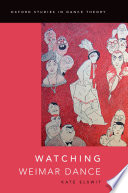
Watching Weimar Dance PDF
252 Pages·2014·17.0434 MB·other
Most books are stored in the elastic cloud where traffic is expensive. For this reason, we have a limit on daily download.
Preview Watching Weimar Dance
Description:
"Watching Weimar Dance" asks what audiences saw in the peculiarly turbulent and febrile moment of the Weimar Republic. It closely analyses the reception of various performances, from cabaret to concert dance and experimental theatre, in their own time and place - at home in interwar Germany, on tour, and later returning from exile after World War II. Spectator reports that performers died or became half-machine archived not only the physicality of past performance, but also the ways audiences used the temporary world of the stage to negotiate pressing social issues, from female visibility within commodity culture to the functioning of human-machine hybrids in an era of increasing technologization. These accounts offer offer limit cases for the body on stage and, in so doing, speak to the preoccupations of the day. Approaching a range of performance artists, including Oskar Schlemmer, Valeska Gert, Kurt Jooss, Mary Wigman, Bertolt Brecht, Anita Berber, and the Tiller Girl troupes, through archives of watching, the reception of these performances also revises and complicates understandings of Ausdruckstanz as the representative dance of this moment in Germany. They further reveal how such practices came to be reconfigured and imbued with new significance in the post-war era. By bringing insights from theatre, dance, and performance studies to German cultural studies, and vice versa, Watching Weimar Dance develops a culturally-situated model of watching that not only offers a revisionist narrative, but also demonstrates new methods for dance scholarship to shape cultural history.
See more
The list of books you might like
Most books are stored in the elastic cloud where traffic is expensive. For this reason, we have a limit on daily download.
